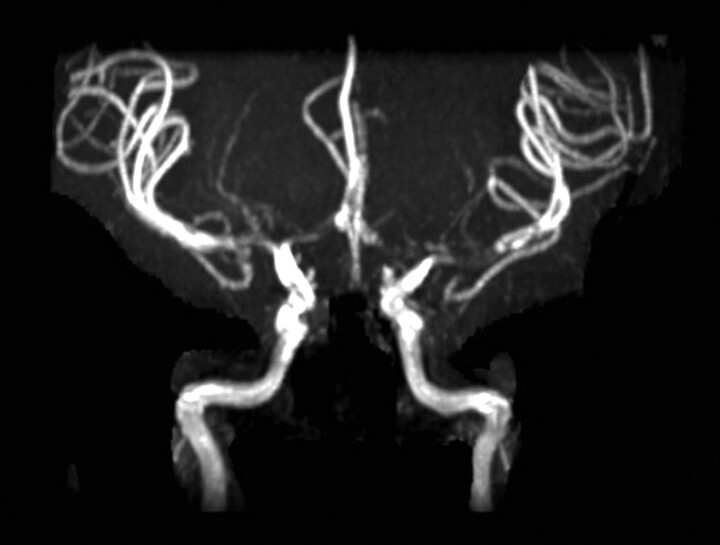Neurologic complications occur in 20%–50% of patients with hemolytic uremic syndrome (HUS). Macrovascular changes are not part of the syndrome. Here, we report a patient with a familial form of HUS who presented with hemodynamic transient ischemic attacks, as a result of severe proximal stenoses of both middle and anterior cerebral arteries.
A 15-year-old girl experienced neurologic symptoms several times in the past few months, consisting of sensory or motor symptoms on either side of the body, with a maximal duration of 5 minutes. All episodes occurred during hemodialysis. She developed end stage renal disease at 3 years of age due to nondiarrheal HUS (D-HUS) and was subsequently treated with peritoneal dialysis and frequent home hemodialysis. She had undergone renal transplantation twice; both renal grafts failed rapidly as a result of recurrent HUS, despite treatment with plasmapheresis. Because of persistent hypertension, both native kidneys had been removed previously. Two of her sisters also developed D-HUS. Mutation analysis revealed a factor H mutation in all 3 girls, consistent with the diagnosis of a familial HUS. Because she often had low blood pressure during hemodialysis (130/70 mm Hg before dialysis; 80/50 mm Hg during dialysis), the episodes were suggestive of hemodynamic transient ischemic attacks. MR imaging of the brain showed no abnormalities. However, at MR angiography, severe stenoses were observed in the proximal segments of both middle and anterior cerebral arteries (Fig 1). Symptoms did not recur after strict blood pressure guidance during hemodialysis. Her 2 younger sisters with D-HUS had never experienced neurologic complications and declined MR angiography.
Fig 1.
Coronal MR angiogram (3D time-of-flight) shows severe stenoses of both M1 and A1 segments.
The cause of the observed intracranial stenoses in our patient is unknown. Because, to our knowledge, macrovascular stenoses and vasospasm have not been described to be part of HUS, the observed findings in our patient might be a complication associated with the chronic renal replacement therapy. Our patient has been on hemodialysis treatment for more than 12 years. Outcome studies have revealed that cardiovascular disease is a relatively prominent complication in children with end stage renal disease and that cerebrovascular accidents account for most deaths in this group.1,2 Although our patient indeed had signs of left ventricular hypertrophy and increased arterial wall stiffening, radiologic evaluation revealed no apparent signs of calcifications or patchy arterial wall thickening, and no other loci of arterial wall narrowing were found.
It could be hypothesized that the proximal cerebral artery stenoses are secondary to the use of cyclosporin A, because the occurrence of vasospasm has previously been described in patients treated with cyclosporin A.3 Our patient was treated with cyclosporin in the past because of 2 kidney transplantations. However, it is unlikely that prior cyclosporin use is the cause because we administered it only twice during a short period of time, for a maximum of 2 months. Because both kidney transplants were rejected, cyclosporin use had been stopped 4 years before the onset of transient ischemic attacks. The patient never had clinical signs of a cyclosporin-associated encephalopathy. Furthermore, in the cases described in the literature, cyclosporin-associated vasospasm was reversible within 1 month after cyclosporin cessation.3
Finally, stenoses of the proximal cerebral arteries may occur in patients with sickle cell disease, Moyamoya disease, and Graves disease.4 Our patient is white, thus very unlikely to have sickle cell disease, and never had symptoms of this disease. Because our patient had no netlike collateral vessels around the circle of Willis, she did not meet the full diagnostic criteria for Moyamoya disease. Besides, she had no stenosis or occlusion in the terminal portion of the internal carotid artery, making Moyamoya disease less likely. Thyroid function in our patient was normal.
References
- 1.Oh J, Wunsch R, Turzer M, et al. Advanced coronary and carotid arteriopathy in young adults with childhood-onset chronic renal failure. Circulation 2002;106:100–05 [DOI] [PubMed] [Google Scholar]
- 2.Groothoff JW, Gruppen MP, Offringa M, et al. Mortality and causes of death of end-stage renal disease in children: a Dutch cohort study. Kidney Int 2002;61:621–29 [DOI] [PubMed] [Google Scholar]
- 3.Lin JT, Wang SJ, Fuh JL, et al. Prolonged reversible vasospasm in cyclosporin A-induced encephalopathy. AJNR Am J Neuroradiol 2003;24:102–04 [PMC free article] [PubMed] [Google Scholar]
- 4.Nakamura K, Yanaka K, Ihara S, et al. Multiple intracranial arterial stenoses around the circle of Willis in association with Graves’ disease: report of two cases. Neurosurgery 2003;53:1210–14 [DOI] [PubMed] [Google Scholar]



